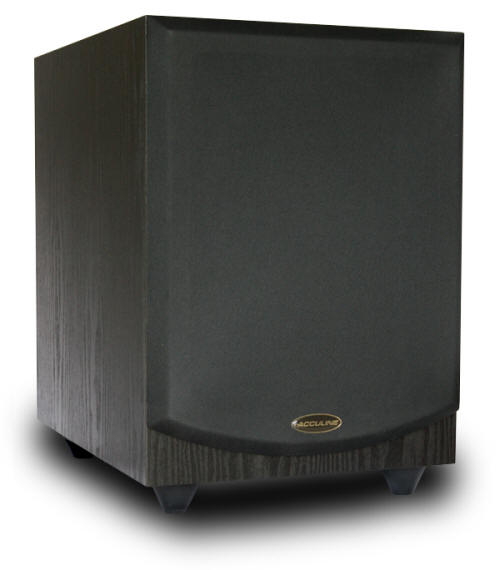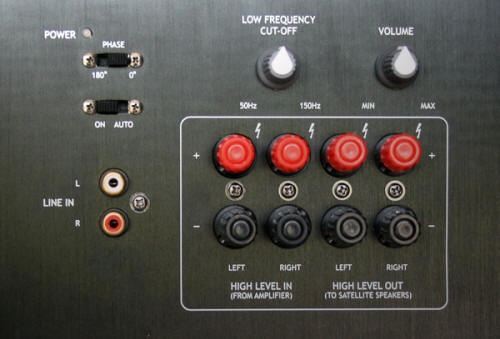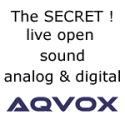
You are reading the older HTML site
Positive Feedback ISSUE
41january/february 2009
acculine
ASub subwoofer
as reviewed by Larry Cox

|
LARRY COX'S SYSTEM
LOUDSPEAKERS
ELECTRONICS
SOURCE
CABLES
ACCESSORIES
|
I've played with subwoofers in my system a few times, mostly as part of a whole home theater system. The subwoofers were included with Niro Nakamichi's Niro system (~$1100), Totem Acoustic's Dream Catcher System (~$1600) and Acoustic Transducer Company's (ATC) fabulous Concept 2 system (then priced at about $11,000). The subs were designed to work with those speaker systems and I guess that made subwoofer integration "easier," if not in reality. This is my way of saying, the subs integrated quite well, and I'm not sure how that happened, good luck, excellent design by the manufacturer or some innate skill about which I am unaware (though not very damned likely).
Among the things I learned were that subs and systems are really designed to fit into rooms, rather than necessarily fitting into a particular pocket book. The Dream Catcher System demonstrated that to me. Totem makes nice sounding speakers some of which are capable of extraordinary sound; but the Dream Catcher System did not capture my dreams, at least not in my 5500 square foot room. In a much smaller room perhaps it would have pressurized the room, delivered bass taut enough to be satisfying and a volume level that did likewise, though it would not likely have been an extraordinary event, i.e. loudness or a visceral impact.
The Concept C2 system was a Ferrari, easily up to taking control of my large listening space. The system played with a visceral impact, the capability to sound great whether the volume level was loud or soft all the while delivering an auditory experience that exceeded every theater I've been in. I surmise that a "step-up" the ATC line into a larger collection of speakers might not have been an improvement in that space; perhaps more would have been simply too much, much as not enough wasn't enough with the Dream Catcher. That ATC system now costs about $27,000, so it's no surprise that it worked better than Totem's Dream Catcher System.
So, that's a long way around to saying, I'm not a subwoofer expert but I've had some experience. Getting great sound out of a $27,000 system is one thing, but getting a satisfying experience out of a much less expensive product is another. This review of the $239 Acculine ASub invites the question whether the performance available at less than $300 is a worthy side trip, or will it suggest that it might it be better to pay more and buy something worth owning.
Acculine is only available through the Internet by a company named www.theaudioinsider.com. They sell a range of inexpensive speakers within the Acculine brand that feature ribbon tweeters, as well as the low cost, high value brands Swans and Dana Design. Acculine is a new name to me, but Swans and Dana Designs have been around for at least ten years each. That's pretty good company, so that encouraged me to try the Acculine ASub.
I chose the Acculine ASub because of my relative ignorance of subwoofers. That the ASubs were really inexpensive made it seem like an interesting test piece. I expect that an Acculine ASub subwoofer's price would attract an inexperienced consumer who is hunting for a price, rather than a particular level of performance, or at least is hoping for performance. Audiophiles who have taken the plunge and previously, if not comfortably, taken the plunge on five hundred or thousand dollar audio baubles probably will shop upline for REL, or HSU or the like, and those are good places to go, too. What, I wonder, would Acculine provide?
Each ASub subwoofer that www.theaudioinsider.com sells, is listed at a reputed $399, but because they treat you as an "an audio insider" (get it?), you get an even better price of $239 each. This price shouldn't be a financial stretch for most, but it might be if that "shopper" is uncertain of the value of a subwoofer.

The ASub comes from good "genes." Jon Lane, who has worked in audio at the retail level for several decades is a horn loving, triode using, reader of Positive Feedback in its print era, and is truly an audio insider, is one of the people behind Acculine. Jon smartly warehouses the Acculine gear in a remote part of Nevada, where rent is cheap; helping to keep down the price you'd pay. Oh, also helping to drive down prices is that these subwoofers are manufactured in China. For some, China is a dirty word, it was for me. But, I've come to think that manufacturing products at a subsistence wage should be done somewhere else, and China is a fine place for that, where the cost of living is a fraction of what it is here.
Jon was prompt in responding to my request; though a bit surprised that someone at Positive Feedback Online would be interested in an Acculine subwoofer. Willing to go along with my game we made arrangements and within a week I had a pair of subwoofers in hand. The subs arrived in good condition, the boxes surviving the jaunt from Reno to Los Angeles unscathed.
The only information contained in the box was a sales brochure listing other Acculine products, including the aforementioned ribbon bearing speakers. There were no setup instructions, descriptions of how to set the controls, or even claimed performance levels. I was disappointed at not seeing any of that information. I expect that potential buyers of the ASub will want and need some hand holding and think this is a mistake. While there is a great deal of information on subwoofer setup available online, none of that is tailor made for the ASub.
And, truth be told, without searching the internet for said setup suggestions, I found it fairly easy to get enjoyable sound from the pair of ASub subwoofers. I placed the subs about the same distance from the wall as my speakers, and as close to the speakers as possible, figuring what worked with my satellites would work with a pair of subwoofers. Why a pair, neophytes might ask? A pair of subwoofers, versus a single subwoofer, provides a smoother response. This means that a single subwoofer will most likely produce a bump or spike in the frequency response, translated that means that a particular (frequency) sound(s) will be reproduced more loudly than those around it. The affect of that is to obscure the surrounding frequencies, often making dialogue, for instance, less intelligible. Using a pair can "null" or diminish the sonic spike, leaving that frequency less loud than it might otherwise be. Thus, allowing dialogue to be more intelligible. So, nulling a spike is a good thing. Again, for the neophytes, it's not just the presence of a subwoofer that will produce a spike; spikes arise based on the dimensions of your room.
It doesn't take being an audiophile to appreciate a smoother response. What a smoother response means to me is that music and movies will retain the scale and proportion that the composer intended. That in turn means that you'll hear the parts of the music or sound that you're supposed to hear in the way that the music or sound was intended to be heard. Finally, that makes it easier to appreciate music and to understand dialogue, etc. So, even if you're not an audiophile, you'll want a smoother response.
To continue, one subwoofer can produce most of the effect of two, but the single subwoofer will probably need to be amplified a little bit louder than a pair is to achieve the same volume level. Playing louder makes things harder on the subwoofer, which in turn increases the likelihood that the amplifier driving or powering the subwoofer will exceed its proper performance range and begin to distort, along with the subwoofer driver itself. Again, this takes you back to ease of appreciating the performance.
Secondly, you may end up having the "frequency" crossover set differently when using only one subwoofer, leading to less optimal performance. The frequency crossover determines at what level the subwoofer curtails its activities; e.g. it only allows frequencies below a certain level to be reproduced by the subwoofer. This allows the subwoofer to perform better. Without specification, I can only guess at what the ASub provides in performance because the dial for crossover lacked demarcations for frequency level.
Jon makes no pretense that the subwoofers are substitutable for $8300 satellite speakers like my ATC SCM 20-2A speakers. But, might they add something to my system? Going to the internet you'll read that it is really difficult to get subwoofers to match the speed of the main speakers. The "difficulty" isn't in getting a bit better performance; it's in getting it seamlessly. The ASubs were a pleasant addition to my system.
With movies, a low, purring bottom end or even a growling low end is enjoyable for a home theater system. Getting a subwoofer to blend with movies is seemingly easy to do. I think this is because sounds from a movie are essentially narrow bandwidth, unconnected data points, as in disparate non-continuous sources of sound, e.g. the range of notes produced by roaring motors, or squealing tires and the like, are quite limited in bandwidth and time, so frequency anomalies aren't as obvious.
While I had the ASubs in house my friend Peter came for a visit. Peter's a satellite engineer and a great guy who loves his basketball almost as much as his daughter. A step down in interest level for Peter is his very nice 42" plasma TV. Has Peter made any efforts at a special setup for his TV? No. As long as he can catch a glimpse of his Lakers while his wife and daughter eat he's good to go. Yet another step down in importance is his small 5.1 stereo that is occasionally hooked up to his plasma. Peter's 5.1 system is that in name only. The subwoofer, such as it is, is in another, unidentified room, along with the surround speakers. So, he essentially has a 3.0 system at home, with no apparent, present intention to alter that scenario. It would be safe to say that Peter is neither an audiophile nor aspires to be one.
Having said that, Peter, who mostly ignores my stereo (though I did get his LP copy of Led Zeppelin IV for my 50th birthday!) volunteered that what the ASubs added to movies with my system was pretty cool. You'll probably wonder why I'm including the "praise" of a person who barely registers interest in sound. Well, I think what the ASub added to my system is exactly what someone with his interest level would want, more foundation and a slightly fuller and warmer sound. So, while Peter isn't the guy to ask about the niceties of audio playback, he probably is the proper demographic for which the ASubs were made.
We watched one of the "extras" on Cars that included a battle of the bands between two one-man bands. It was this presentation that sparked Peter's acknowledgment and appreciation. And, I can't argue that what the ASubs added were nice.
Frequency discontinuities in Ice Age, Cars, and The Land Before Time (I'm not recommending these as reference level source material, but as what I listened to while Peter was visiting) or the many other movies we had on hand, weren't obviously noticeable. And, I'd say that for movie fare with explosions, thundering feet and squealing tires the extra foundation of the ASubs were cool. The sound was akin to classic tube equipment, fuller and a bit less fast than you'd expect from solid state, though the ASubs are solid state designs
Now, as the person in the room with his underwear, er ears, on a bit tighter, there were shortcomings that manifested easily to me on the one-man band tracks. While there was an addition of bass, to get a level of "integration" or at least a not obviously disintegrated sound, required that I back off on the volume levels. Doing that allowed for a sound that approached a level of integration that wasn't distractingly off. This is to say that I had to balance the subwoofer's ability to play loud while keeping up with the main speakers speed.
Counterpoised to squealing tires and the plodding footsteps of monsters, music was not as well integrated with my main speakers, and this was where the cat was let out of the bag. The ASubs inability to play loud at the speed, and tightness, if you will, of my speakers was more obvious. While it was not obviously off like Heath Ledger's Joker, the bass roll-off was pronounced, especially after spending time with the ATC SCM 100P speakers.
Bass became overblown, and either too prominent and slow or lower in output level so as to remain controlled. Frankly, that was OK for me. I believe that the reason that discontinuities are more easily distinguished with sound effects is that there are instruments that traverse multiple octaves and when parts of the instruments bandwidth are replayed "out of whack" well, it's just more obvious.
To summarize, over the course of this review, I found that what was unacceptable with music, was OK even fun with movies. And discontinuities were not a problem with the sound affects while watching Ice Age, Cars, Shrek and the like (you think I might have a kid?) The same volume levels of subwoofer, though sounded boomy and off when playing Mark Knopfler's "Golden Heart" from the Golden Heart CD or Israel Kamaka wiwo' ole's Facing Future, in particular "Hawai'i '78" where a very large drum or other percussion instrument fills out the bottom end.
In short, the ASubs were mismatched to my speakers. Where's the surprise when the pair of subwoofers cost 1/17th of the cost of the main speakers. In their proper application, perhaps like Peter's system, they're a pleasure. While the ASubs weren't keepers for my exotica, in a less ambitious system and a smaller room, and in particular for a home theater application, I think they're a solid choice. Keep in mind that while most of the PFO listening audience aren't going to be going to the ASubs, your friends will be well served; after all, how many of your non-audiophile friends think, worry, and perhaps even dream about audio at all? Enjoy. Larry Cox
ASub
Retail: $239
Acculine
web address:
www.theaudioinsider.com

